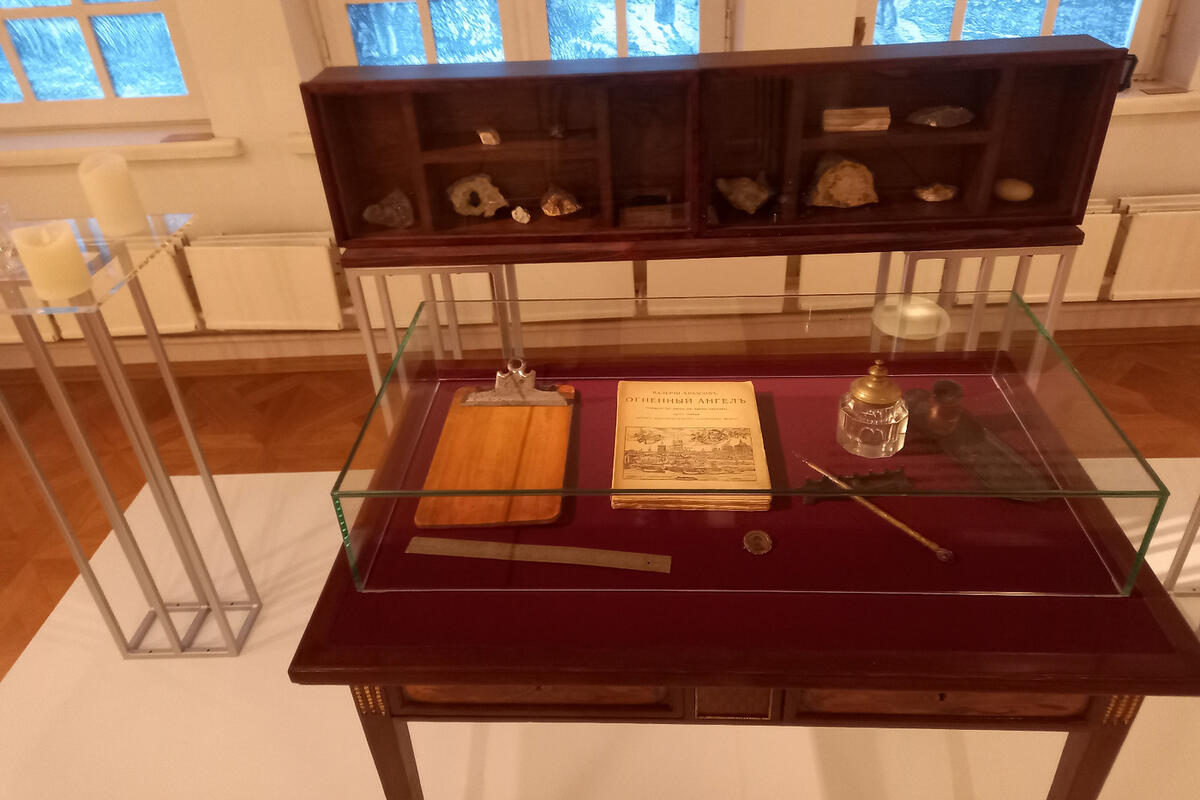Symbolist from the banks of the Yauza: an exhibition dedicated to the 150th anniversary of Valery Bryusov has opened
[ad_1]

An exhibition has opened in Moscow to mark the 150th anniversary of Valery Bryusov, who lived from 1910 to 1924 in a mansion that today houses one of the main departments of GMIRL. The MK correspondent walked through the two halls three times – first with a camera, then with “empty hands” so as not to be distracted by anything, and the third time with the curator of the “Rise of Fire” project, candidate of philological sciences Monika Orlova.
Bryusov’s house is intended to form an idea of the entire Silver Age, and it is clear that there the poet reigns as the owner. The mansion never belonged to Valery Yakovlevich, but these are details: the memorial office and many Bryusov artifacts in the permanent exhibition tell about it in sufficient detail. At the same time, according to Orlova, the exhibits at the exhibition are not duplicated – the museum’s collection is so extensive that it allows it not to be repeated.
“With what we have, we aimed to show off the gems. Childhood, family, immediate environment,” says Monika Orlova. And it leads to a simple lithograph with the caption “View from the Yauzsky Bridge.”
— Here is the answer to the question of how Russian symbolism began. Yauzsky Boulevard, geese. And next to it we hung exquisite graphics by Konstantin Somov (one of the founders of the World of Art. – I.V.), Nikolai Feofilaktov and other subtle things.
And indeed, if we recognize the primacy of Bryusov as the first Russian symbolist (in a letter to Verlaine, at least, he calls himself the founder of a new movement in Russia), then it turns out that from the Yauza, near which the classic spent his youth, there are rivers with eternal washings in it and with cackling birds, as from Gogol’s “The Overcoat,” a Russian refraction of new aesthetics and new literature arose.
Therefore, it is difficult to call the main thing at the exhibition photographs of Bryusov’s women, including a unique portrait of Ioanna Matveevna Bryusova with a pencil signature, photographs of Elena Maslova, Nina Daruzes, Vera Komissarzhevskaya. Or typescripts with author’s notes (though these are copies) and original manuscripts, lifetime publications, books with dedicatory inscriptions, numerous things that belonged to the poet: a paper press, abacus, postcards brought from trips abroad. Undoubtedly, all this is interesting, just as the part of the biography is interesting when the writer was a war correspondent – the First World War was going on. Hence the map of the Warsaw province and the Belgian theater of military operations, a lithograph of the battle near Warsaw and the epic battle with the Austrians, the business card of the correspondent of the newspaper “Russian Vedomosti” V.Ya. Bryusov and the translation into Mickiewicz’s language of the poem “Poland”, written on August 1, 1914.
Something else is fascinating, namely a series of out-of-time sketches for covers of the Libra magazine and books from the Scorpio publishing house. “Scales”, under the actual leadership of Bryusov, was published since 1904 (this is clearly evidenced by typographic clichés made of wood and metal) and was not only the “mouthpiece” of Russian symbolism, but seemed to contain within itself the germ of the future Acmeism and all poetry of the 20th century.
If you simply put side by side the cover of Bryusov’s book “Urbi et Orbi” (“To the City and the World”) from 1903 and “Anna Akhmatova’s Evening” from 1913, we will see a genetic connection, continuity, this is a fact, but something else is certain: Bryusov and like-minded artists, as they would say today, “set the trend” for decades.
But not only poetry was illuminated by the lightning of revolutionary changes by the poet – his pseudo-medieval novel “Fire Angel”, to which museum workers dedicated a separate room, was a vivid hoax, where behind the images of those living in Germany in the 16th century there were “avatars” of Bryusov himself, Andrei Bely and Nina Petrovskaya (the term The “love triangle” is cheesy, but these three made up exactly that).
Faustian mysticism, witches and the tortured methods of fighting them by the Inquisition, captured in ancient engravings, the image of an “alchemy cabinet” created using dummies of flasks and real minerals and stones (from Bryusov’s collection), plus all this in the light of almost real candles, It would seem that they could frighten children – and their literature teachers will inevitably take them to the exhibition. But the curator assured that the schoolchildren react calmly to what they see. And if by the time of their visit they had already read Goethe and Bulgakov’s “The Master and Margarita,” the shimmering mystery will seem understandable and aesthetically motivated to them.
It remains to add that the real tailcoat of Valery Bryusov was also placed in the “German”, or more precisely, in the “Cologne” hall. True, you have to be especially careful with this fragile and fearful thing. If there are no visitors, the lights in the room are immediately turned off. Therefore, there is an idea to make a modern repetition of a priceless wardrobe item.
[ad_2]
Source link






